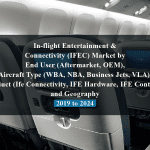OVERVIEW
The Hypersonic Flight Market is currently valued at USD 782 million in 2024 and will be growing at a CAGR of 5.7% over the forecast period to reach an estimated USD 1,154 million in revenue in 2029. he hypersonic flight market is a burgeoning sector characterized by the development and deployment of aircraft capable of sustained flight at speeds exceeding Mach 5, or five times the speed of sound. This cutting-edge technology promises revolutionary advancements in air travel, military capabilities, and space exploration. With the potential to significantly reduce travel times across the globe and enhance the responsiveness of military operations, hypersonic flight has attracted considerable attention from aerospace companies, governments, and research institutions worldwide. However, challenges such as engineering complexities, material limitations, and regulatory hurdles remain to be addressed for the widespread commercialization of hypersonic vehicles. Despite these obstacles, the market continues to witness rapid growth driven by ongoing technological innovations and strategic investments in research and development initiatives.
Firstly, the increasing demand for faster and more efficient transportation solutions is propelling research and investment in hypersonic technology. With the potential to drastically reduce travel times for both commercial and military purposes, hypersonic flight offers a compelling solution to meet the evolving needs of global connectivity and security. Moreover, advancements in materials science and engineering are overcoming previous technical barriers, making hypersonic flight more feasible and economically viable. Additionally, geopolitical tensions and the pursuit of military superiority are driving governments to prioritize the development of hypersonic weapons and surveillance platforms, further stimulating market growth. Furthermore, the involvement of private aerospace companies and collaborations between industry players and government agencies are fostering innovation and accelerating the commercialization of hypersonic technologies.
Table of Content
Market Dynamics
Drivers:
Firstly, the increasing demand for faster and more efficient transportation solutions is propelling research and investment in hypersonic technology. With the potential to drastically reduce travel times for both commercial and military purposes, hypersonic flight offers a compelling solution to meet the evolving needs of global connectivity and security. Moreover, advancements in materials science and engineering are overcoming previous technical barriers, making hypersonic flight more feasible and economically viable. Additionally, geopolitical tensions and the pursuit of military superiority are driving governments to prioritize the development of hypersonic weapons and surveillance platforms, further stimulating market growth. Furthermore, the involvement of private aerospace companies and collaborations between industry players and government agencies are fostering innovation and accelerating the commercialization of hypersonic technologies.
Key Offerings:
In the hypersonic flight market, key offerings encompass a range of technologies, services, and solutions aimed at enabling and supporting hypersonic flight capabilities. These offerings include advanced propulsion systems capable of sustaining flight at speeds exceeding Mach 5, innovative airframe designs optimized for high-speed performance and aerodynamic efficiency, cutting-edge materials engineered to withstand extreme temperatures and stresses encountered during hypersonic flight, and sophisticated guidance, navigation, and control systems to ensure precise maneuvering and safe operation. Additionally, comprehensive testing facilities and simulation tools are essential offerings for validating and refining hypersonic vehicle designs and performance characteristics. Furthermore, consultancy services, training programs, and collaborative research initiatives play a crucial role in facilitating knowledge transfer, skill development, and collaborative innovation across industry stakeholders.
Restraints :
Although hypersonic flight technology has great potential, a number of obstacles prevent widespread acceptance and commercialization. Creating materials that can endure the high temperatures and pressures encountered during hypersonic flight presents a huge engineering problem that frequently calls for expensive and time-consuming research and development. The integration of hypersonic vehicles into the current aviation infrastructure is further complicated by legislative frameworks controlling airspace access, environmental issues, and safety standards. Additionally, the high expenses of researching, developing, and testing hypersonic technology, combined with the unpredictability of market demand and return on investment, present financial challenges for investors and industry participants. Additionally, the export and spread of hypersonic weaponry systems may be restricted by geopolitical conflicts and international arms control agreements, which would limit market prospects in particular areas. To overcome technological, legal, and financial obstacles and realise the full promise of hypersonic flight technology, industry, government, and research institutions must work together to solve these constraints.
Regional Information:
• In North America, particularly in the United States, the hypersonic flight market is driven by significant investments from both government agencies, such as NASA and the Department of Defense, and private aerospace companies like SpaceX and Lockheed Martin. These investments are aimed at advancing hypersonic technology for military applications, including next-generation missile systems and reconnaissance platforms. Additionally, the United States is home to leading research institutions and testing facilities, such as NASA’s Armstrong Flight Research Center and the Arnold Engineering Development Complex, which play a crucial role in developing and validating hypersonic technologies. However, regulatory challenges and budgetary constraints may impede the pace of commercialization in this region.
• In Europe, countries like Russia and France have made significant strides in hypersonic technology development, with Russia notably achieving several successful hypersonic missile tests. Collaboration between European Union member states and partnerships with aerospace industry leaders, such as Airbus and Thales Group, drive innovation in this region. However, geopolitical tensions and export restrictions may hinder broader market growth and international cooperation.
• In Asia-Pacific, countries like China and Japan are emerging as key players in the hypersonic flight market, investing heavily in research and development initiatives. China, in particular, has made notable advancements in hypersonic weapons technology, raising concerns among neighboring countries and contributing to regional security dynamics. Meanwhile, Japan focuses on leveraging its expertise in materials science and engineering to address key technical challenges in hypersonic vehicle design. Collaborations between government agencies, academia, and industry stakeholders are driving progress in this region, although geopolitical rivalries and regulatory barriers may pose obstacles to market expansion.
Recent Developments:
• In January 2023 , US Department of Defense (DoD) awarded a contract USD 334 million as part of its project mayhem Leidos (US) to develop both hypersonic weapon and hypersonic aircraft. The Contract is awarded for a duration of 6 years.
• In August 2021, Hermeus (US) received an investment worth USD 60 million for the development of hypersonic military aircraft.
Key Market Players:
SpaceX, Lockheed Martin, Boeing, Northrop Grumman, Airbus, Thales Group, Raytheon Technologies, BAE Systems, Reaction Engines, and Aerojet Rocketdyne.
Frequently Asked Questions
1) What is the projected market value of the Hypersonic Flight Market ?
– The Hypersonic Flight Market is expected to reach an estimated value of USD 1,154 million in revenue by 2029.
2) What is the estimated CAGR of the Hypersonic Flight Market over the 2024 to 2029 forecast period?
– The CAGR is estimated to be 5.7% for the Hypersonic Flight Market over the 2024 to 2029.
3) Who are the key players in the Hypersonic Flight Market ?
– SpaceX, Lockheed Martin, Boeing, Northrop Grumman, Airbus, Thales Group, Raytheon Technologies, BAE Systems, Reaction Engines, and Aerojet Rocketdyne.
4) What are the drivers for the Hypersonic Flight Market ?
– The growing demand for faster transportation solutions is driving research and investment in hypersonic technology, offering a solution for global connectivity and security. Advancements in materials science and engineering, geopolitical tensions, and collaborations between private aerospace companies and government agencies are accelerating the commercialization of hypersonic technologies.
5) What are the restraints and challenges in the Hypersonic Flight Market ?
– Hypersonic flight technology faces challenges in widespread adoption due to engineering hurdles, regulatory frameworks, high costs, market demand uncertainties, and geopolitical tensions. These factors hinder the integration of hypersonic vehicles into aviation infrastructure, posing financial and market barriers. Collaboration between industry, government, and research institutions is needed to overcome these obstacles and unlock the full potential of hypersonic flight technology.
6) What are the key applications and offerings of the Hypersonic Flight Market ?
– The hypersonic flight market offers advanced propulsion systems, optimized airframe designs, materials for extreme temperatures, and sophisticated navigation systems. Testing facilities, simulation tools, consultancy services, training programs, and collaborative research initiatives are essential for validating vehicle designs and facilitating knowledge transfer and innovation.
7) Which region is expected to drive the market for the forecast period?
– North America is expected to have the highest market growth from 2024 to 2029
Why Choose Us?
Insights into Market Trends: Global Market Studies reports provide valuable insights into market trends, including market size, segmentation, growth drivers, and market dynamics. This information helps clients make strategic decisions, such as product development, market positioning, and marketing strategies.
Competitor Analysis: Our reports provide detailed information about competitors, including their market share, product offerings, pricing, and competitive strategies. This data can be used to inform competitive strategies and to identify opportunities for growth and expansion.
Industry Forecasts: Our reports provide industry forecasts, which will inform your business strategies, such as investment decisions, production planning, and workforce planning. These forecasts can help you to prepare for future trends and to take advantage of growth opportunities.
Access to Industry Experts: Our solutions include contributions from industry experts, including analysts, consultants, and subject matter experts. This access to expert insights can be valuable for you to understand the market.
Time and Cost Savings: Our team at Global Market Studies can save you time and reduce the cost of conducting market research by providing comprehensive and up-to-date information in a single report, avoiding the need for additional market research efforts.












